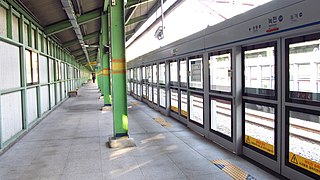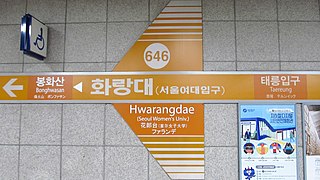
Seoul Subway Line 2, also known as the Circle Line, is a circular line of the Seoul Metropolitan Subway. The line running clockwise is called the "inner circle line" and the counter-clockwise line is called the "outer circle line". This is Seoul's most heavily used line, and consists of the main loop, the Seongsu Branch and the Sinjeong Branch for a total line length of 60.2 km (37.4 mi). The Line 2 loop is the third longest subway loop in the world after Moscow Metro Bolshaya Koltsevaya line and Beijing Subway Line 10. In 2019, Line 2 had an annual ridership of 812 million passengers or 2.2 million passengers per day.

Jongno 3(sam)-ga Station is an underground station on lines 1, 3 and 5 of the Seoul Subway in South Korea.

Myeong-dong Station is a station on the Seoul Subway Line 4. This station is located in Jung-gu, Seoul.

Sindorim station is a station on Seoul Subway Line 1 and Line 2 (underground). It is also the southeastern terminus of Line 2's Sinjeong Branch to Kkachisan. The station is located at the northern edge of Sindorim-dong, Guro-gu, Seoul, on the border with Yeongdeungpo-gu.

Ichon Station is a station in Yongsan-gu, Seoul on Seoul Subway Line 4 and the Gyeongui–Jungang Line. This station is the closest to the National Museum of Korea, situated in the interior of Yongsan Family Park. It also serves eastern Ichon-dong, home to the largest Japanese community in South Korea with some 1,300 Japanese residents.

Dorimcheon (Korean: 도림천역) is a station on the Sinjeong Branch of the Seoul Subway Line 2. It is the least-used station on Line 2. This station is located in Sindorim-dong, Guro-gu, Seoul.

Yangcheon-gu Office Station is a station on the Sinjeong Branch of the Seoul Subway Line 2. This station is located in Sinjeong-dong, Yangcheon-gu, Seoul. It is named after the city hall of Yangcheon-gu district; Yangcheon means "sunny stream".

Gangseo District (Gangseo-gu) is one of the 25 wards (gu) of Seoul, South Korea. It is located on the south side of the Han River. Gimpo Airport is in Gonghang-dong, where many flights fly to cities like Busan, Jeju, and Gwangju.

Chang-dong Station is a station on Seoul Subway Line 1 and Line 4. It is located in Chang-dong, Dobong-gu, Seoul. A shopping center was planned for this site, but the empty lot has never been developed due to the bankruptcy of the contractor behind said project. The station is, however, home to a cluster of pojangmacha stalls.

Mangwolsa Station is a metro station on Seoul Subway Line 1. Named after a Silla-era Buddhist temple in the mountains to the west, it is the first station for services leaving Seoul heading north, and lies in the city of Uijeongbu.

Dobong Station is a metro station on Seoul Subway Line 1. It is in the extreme north of Seoul and offers services connecting the city to the cities to the north in Gyeonggi-do.

Banghak station is a subway station on Line 1 of the Seoul Metropolitan Subway. It is the closest station to the Dobong-gu District Office in Seoul.

Nokcheon station (Korean: 녹천역) is a metro station on Seoul Subway Line 1 in South Korea. It is located in the northern end of the city.

Ujangsan Station is a station on the Seoul Subway Line 5 in Gangseo-gu, Seoul. It is named after a nearby mountain to the east.

Gyeongbokgung station is a subway station on Line 3 of the Seoul Metropolitan Subway. It is the subway station nearest to the Gyeongbokgung Palace. The station is also near the Government Complex–Seoul, the National Police Agency of South Korea, and other administrative buildings in the neighborhood.

Sangil-dong station is the subway station of Line 5 in Gangdong-gu, Seoul. Seoul Metro have extended the subway line from this station to Hanam Geomdansan in the nearby city of Hanam.

Dongducheon Jungang Station (Korean: 동두천중앙역) is a train station on the Seoul Subway Line 1 and the Gyeongwon Line. The name means Dongducheon Central Station. It was also once known as Eosu-dongStation.

Nam District (Nam-gu) is a district of Ulsan, South Korea. Its name literally means "South Ward".

Juan station is a subway station on the Seoul Metropolitan Subway Line 1 and Incheon Subway Line 2. This station receives the second-highest number of crowds along the entire Incheon line due to its proximity to the downtown area. It is also near Inha University and Inha Technical College.

Hwarangdae Station is an underground Metro Seoul station in Seoul, South Korea, served by the line 6. The station is located in Gongneung-2(Yi) dong located near Korea Military Academy, where its name comes from, Seoul Women's University and Sahmyook University, and it opened in 2000.






















